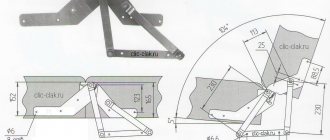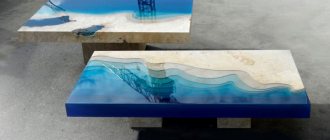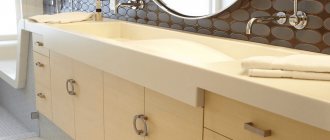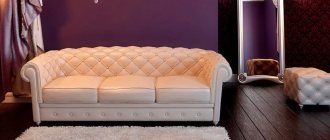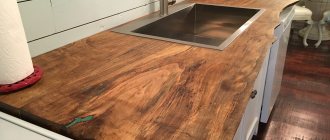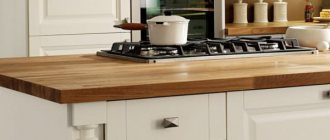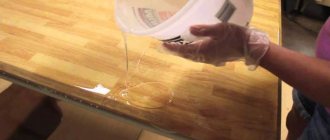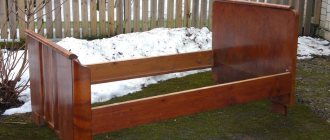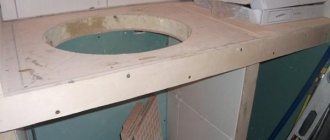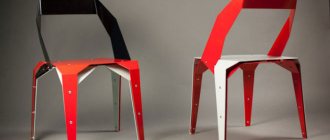Any furniture is not eternal, and tabletops are no exception, no matter how reliable the materials from which they are made are. Sooner or later, chips and other damage appear on them. But the good news is that you can fix this problem yourself without turning to specialists.
Deep cracks
The most important thing here is not to leave the crack empty. In this case, it is best to adhere to certain rules:
- The crack must be protected from dust and dirt.
- Use wood putty to fill the damaged area.
- In the case where the surface is covered with paint or varnish, it must be cleaned with sandpaper.
- You can use stain to give the desired shade.
When the apartment contains very expensive or perhaps exclusive furniture, it is worth turning to professionals. They will help correct all defects without side effects.
PVA glue
Acetate glue, which contains natural substances, does a good job of sealing cracks in fiber boards. To do this, fill a syringe with it and inject it deep into the cleft using a needle. The glue must be applied carefully and strictly to the crack so that lumps do not form. After this, the part is tightened with clamps and waited until completely dry.
Oddly enough, this rich egg sauce can work real miracles. Of course, if the crack is not through. Mayonnaise is applied carefully and only to the crack itself, without affecting the surrounding areas, otherwise you will also have to get rid of greasy stains later. The composition is left on the problem area overnight, and the excess is polished with a soft cloth. If necessary, the remaining scratch or unevenness is masked with furniture wax or other suitable material.
Whichever method you choose, remember that it is better to first try it on an inconspicuous area, such as the inside of a countertop or drawer. This way you will definitely save your family budget from additional expenses, and yourself from unnecessary hassle and running around in search of new concealers.
When wiping dust from wooden furniture, it is difficult not to notice cracks, scratches, and abrasions. All these are integral companions of time, appearing in the process of using furniture. Even small errors on the surface are clearly visible. They spoil the perfect appearance of a varnished product and leave an unpleasant aftertaste.
Scratches and chips on wooden furniture or doors are a common problem encountered in almost every home.
You can treat the furniture with a mixture of vinegar and olive oil, using it as a polish, and then wipe it dry
Wood stain can help, as it is the best way to remove scratches on furniture.
While minor damage can be easily removed using home methods, masking deep defects requires the use of only professional products. In particular, putties. Puttying will allow you to achieve a uniform, clean, even coating.
The putty is carried out in two stages - first the main chip is repaired, and after drying the finishing layer is applied, with a slight excess
Preparing the site
Before starting work, you need to thoroughly clean the surface of the furniture from dust and dirt. The cleaned area is coated with a degreasing agent and allowed to dry. Also at the preparation stage, you need to decide what material will be used to hide defects.
Applying the material
The purchased material is applied with a suitable tool or cotton pad to the damaged area. When applying, try to ensure uniformity. Excess material is carefully removed with a spatula.
Painting
A layer of paint is applied on top of the applied masking material, which matches the color of the rest of the furniture. Paint not only visually hides defects, but also provides additional protection against new damage.
Removing scratches from a countertop
Removing scratches from a countertop
The covering of the work area in the kitchen can be made of a variety of materials. How to eliminate scratches that spoil the appearance of the countertop will depend on their properties and characteristics. What types of countertops are there and how to remove scratches from them will be discussed in this article.
Modern kitchen countertops can be made:
- from natural stone: marble or granite;
- made of artificial stone or hard plastic;
- made of wood;
- using laminated coating.
Not a single material used in the kitchen work area is immune to cracks, chips or scratches. In case of minor damage, the surface can be restored without having to replace the entire canvas.
First of all, it is worth recalling that minor scratches from almost any surface can be removed using a regular automotive aerosol. Complete surface treatment will make the coating smooth and beautiful. A detailed method of use is described in the instructions for the material.
Restoration of a natural stone countertop
Granite or marble is most often used as a natural material for countertop coverings. Despite the high natural strength of these materials, scratches as a result of use cannot be avoided.
To remove scratches from a natural stone surface, use a polishing paste based on chromium oxide. For this:
- the paste is applied to a piece of woolen cloth,
- Rub the damaged area with rotational movements for 15 minutes.
It is advisable to treat the restored surface with a special compound to avoid scratches in the future.
Granite countertops will last a long time and of high quality if you do not use abrasive agents when cleaning, and to avoid the formation of chips and cracks, do not hit it with heavy objects.
Important! For granite countertops, it is not safe to use highly acidic liquids, such as vinegar or lemon juice, alkaline cleaners, wine, and liquids containing acetone.
How to remove a scratch from a wooden tabletop
Solid wood requires special care during operation and additional protection from external influences. As a preventive measure, periodic (once every three months) wiping the countertop with oil (you can use olive oil) and leaving it to dry is usually used.
Minor but unpleasant scratches on wood can be hidden by rubbing the damaged area with a walnut. For walnut, oak or mahogany, you can use iodine for the same purpose, applying it to a small brush and carefully treating the scratches.
If chips, dents or cracks appear on a wooden tabletop, you can use special furniture wax. To remove damage, soft wax should be melted, and using a small spatula, fill the scratch or chip, cut off excess wax that protrudes beyond the edges, and polish the surface.
Sometimes the wax does not always perfectly match the color of the tabletop, then it is possible to tint it using a suitable marker or felt-tip pen.
A crack that appears on a wooden table can be removed using mayonnaise, no matter how strange it may sound. Thanks to the abundance of protein and fat included in this food product, the tree will swell and restore its structure to its original state.
Table top made of artificial stone. Removing scratches
For artificial stone, a special adhesive designed for joining such countertops is ideal. It is necessary to select a material of the appropriate shade.
- The scratch is filled with glue, being careful
- Leave to harden
- Rub the resulting tubercle with a hard cloth.
For matte surfaces, thorough rubbing of the damaged area with a polishing compound is not recommended, since in this case it will be significantly different from the entire surface.
When caring for a tabletop made of hard plastic in the future, you should avoid wiping it with hard brushes, and give preference to a soft cloth, otherwise new scratches may form.
Restoration of a laminated countertop
Despite the practicality and high performance characteristics of laminated countertops, as a result of improper handling, scratches form on them. The main reason for their appearance is cutting food with a knife without a cutting board.
It is possible to restore a damaged laminated surface using special pastes and putties for laminate, sold in hardware stores or from the manufacturer of your countertop. The paste allows you to completely fill the scratch and restore the surface to its original appearance.
To restore a countertop using laminate paste you need to:
- clean and degrease the surface;
- apply the paste in layers, following the instructions;
- level the surface with a spatula;
- Leave for a day for the composition to dry completely.
The laminated surface can also be restored using furniture wax. In addition to applying the composition to the damaged area, it is also necessary to use a cloth to distribute the wax over the entire area of the countertop to give a uniform shine.
Restoration of wooden surfaces
No matter how carefully you handle the furniture, abrasions, scratches, and stains still appear. They are easy to eliminate. The main thing is to know how and with what.
- If the wooden surface has simply lost its shine, find a wood care product that contains orange oil. Take a clean sponge, dampen it slightly and microwave for 20-30 seconds. Spray the product from a spray bottle, then wipe with a hot sponge (hands should be wearing rubber gloves with a coating on the inside).
- More serious stains require serious measures. These are retouching markers (available in furniture stores), denatured alcohol and wax. First, clean the surface (dishwashing detergent diluted in water is the best solution). After cleaning, dry the wood with alcohol: use a moistened swab to rub the lightened areas well. In most cases, the color is restored. In deep scratches, alcohol does not restore the color; they are painted over with a marker of a suitable color. To add shine, the top surface is covered with wax and polished with a soft cloth.
- If you need to smooth out small unevenness, you can use a nail file. For meticulous work, it is easier to use than sandpaper.
- If the wood is locally swollen from moisture: place a leaking vessel, you can quickly get rid of the defect and neutralize its consequences by mixing salt and olive oil. The paste is applied to the damage and rubbed in a circular motion. Leave for 20-30 minutes. The salt will draw out the water, and the olive oil will restore elasticity to the fibers.
- If there are chips, you cannot do without putty. Suitable for both wood and automotive applications. The best way is to buy a light one and add color to it as needed. The chip is covered, a little putty is spread on the adjacent surface. After drying, everything is smoothed out well with fine-grain sandpaper.
If there are scuffs or stains on the wood, you can try to get rid of them by rubbing it with a banana skin. It works well for minor injuries.
You might be interested in reading what types of wall shelves there are (with drawings).
Prevention of chipping
In order for the tabletop to retain its presentable appearance for as long as possible and you do not have to restore it, it is important to maintain its integrity during use.
- special coasters and mats for dishes
in your arsenal . This will protect the surface from sudden temperature changes and dirt that can become embedded. Frequent rubbing can also cause unsightly abrasions. - Do not forget to use care products for the material from which the countertop is made. For example, wooden surfaces are treated with silicone and moisture-resistant sealants. Immediately after purchase, it is advisable to cover their ends with plastic strips and varnish. This will extend the life of the countertop.
- Locate the surface away from possible impact loads: for example, from the front door or refrigerator door.
As you can see, almost every type of damage has its own restoration technique, which you can do yourself. This will save your finances and does not require much work. The main thing is to choose the right materials and act as carefully as possible.
Subscribe to our Social networks
Principles and instructions for restoring chips on a countertop
Knowing how and what you can use to repair a chip or crack on a tabletop, it’s not difficult to repair the furniture structure yourself
At the same time, it is important to comply with technological requirements and use effective options for restoration compositions
Restoration of wood and laminated chipboard countertops
When solving the problem of how to repair a chip on a chipboard tabletop, repair work involves the following algorithm:
- use a hairdryer to warm up the damaged area;
- remove the exfoliated layer, clean the defect area;
- apply glue and leave for 15 minutes;
- prepare the restoring composition in the form of a homogeneous thick mixture of sawdust and PVA glue, leave for 10 minutes;
- the damaged area is sealed with the prepared mixture, the mixture is compacted with a spatula, and the excess is removed.
Restoring a wooden countertop takes at least 24 hours
At least 24 hours are required for complete drying, after which the repaired particle board material is ready for use.
To disguise scratches on a wooden countertop, you should sand the surface and sand it. At the final stage, felt is used to provide a glossy finish. To eliminate chips on a wooden base, mix sawdust and PVA glue and fill the voids, which are first cleaned, blow-dried and sanded.
Plastic countertop repair
Deciding how and with what to repair cracks and chips on a plastic countertop in the kitchen should depend on the complexity of the deformation:
- minor damage to the plastic surface can be repaired using superglue or Moment glue;
- in some cases, restoration of the working plane requires the use of special glue for plastic. The composition is applied using a gun;
- If a fragment of a plastic structure breaks off, Titan glue is used for restoration.
To restore chips, it is recommended to grind the plastic into crumbs or powder, mix well with Titan glue and repair the damaged areas of the structure.
Restoring an artificial stone countertop
Cracks and chips on the working surface made of artificial stone are repaired using polyester resins. The algorithm of restoration procedures includes the following manipulations:
- the damaged area is cleaned and degreased;
- if necessary, the chip site is slightly deepened and widened;
- seal the defects with polyester resin and leave to dry completely for a day.
Next, you need to sand the coating with fine sandpaper, followed by polishing with felt. Small scratches on artificial stone can be easily masked with a repair acrylic compound or a glossy solution. I’m planning how to remove a chip on a stone countertop in the kitchen, using PVA glue, abrasive material of different grain sizes and felt.
- prepare the surface by sanding and grinding the damaged areas;
- prepare a restorative composition from acrylic plastic with the addition of an adhesive mass to a thick, uniform consistency;
- The restoration mixture is used to seal the depressions, chips, cracks and leave until complete polymerization;
- Next, the coating is polished with an abrasive material; at the final stage, it is necessary to polish the surface with felt.
Restoring an artificial stone countertop
Stone countertops with minor defects are often repaired using a grinding machine.
To do this, at the first stage, grind and polish the base; this will help to easily eliminate traces of careless use of the working surface. Next, the material is treated with special reducing solutions. Then they go through the grinding unit again: first with an abrasive, and then with a polishing disc.
At the same time, small cracks and chips are eliminated, the stone base acquires an aesthetic appearance and presentability
Then they go through the grinding unit again: first with an abrasive, and then with a polishing disc. At the same time, small cracks and chips are eliminated, the stone base acquires an aesthetic appearance and presentability.
The nuances of glass countertop repair
A kitchen countertop made of glass is difficult to restore, so care and attention are required when using it. Special equipment is used to remove small scratches. This requires skill and skills in working with fragile materials.
If, as a result of careless handling, defects in the form of cracks or chips have formed on the surface, the structure will have to be replaced with a new one, since it will be difficult and expensive to restore the integrity of the glass tabletop
Features of the operation of the countertop and indications for repair
This element of the kitchen set is subject to intensive use, as it simultaneously performs several functions:
- It is a work surface and is actively used in cooking;
- used as a place to install kitchen equipment;
- It is often used as a bar table or serves as a full-fledged kitchen table.
The structure is subjected to various loads, including thermal, mechanical, and vibration. Due to the active use of the surface, sometimes there is a need for emergency repairs to eliminate chips or scratches on the countertop.
Tabletop requirements:
- heat resistance;
- moisture resistance;
- inertness to the effects of UF radiation;
- ease of care;
- presentable appearance.
The countertop must have heat resistance.
When arranging a kitchen, various countertop options are in demand, each of which has a number of advantages and disadvantages.
Wooden
The wooden work surface has high functional and aesthetic characteristics. Among the advantages of the model, the following positions are noted:
- environmental friendliness of the base;
- resistance of the material to temperature changes;
- ease of use;
- presentable;
- compatibility with kitchen interior elements of any style.
In addition, the problem of how to repair chips and other defects on a wooden countertop at home is easily solved here. The disadvantages of using a wooden structure include:
- flammability - the material is highly flammable, caution is required when used in combination with a gas stove;
- susceptibility to mechanical stress - models made of soft wood are easily scratched by a knife, abrasives, or the sharp edge of kitchen utensils;
- high cost - products made from noble species are sold many times more expensive than analogues made from plastic, chipboard or stone.
A structure made of natural wood gets dirty easily, so it is important to provide coating with special compounds. Most often, wooden surfaces in the kitchen are damaged due to contact with moisture. Also, the material is often deformed as a result of exposure to high temperatures.
Made of plastic
Plastic surfaces are made in the form of imitation of various natural bases; most often they produce models imitating wood or stone. Advantages of plastic countertops:
- ease of use and maintenance;
- variety of solutions;
- resistance to mechanical damage;
- ease of eliminating surface defects using improvised means;
- availability of offers.
Minuses:
- fire hazard – the polymer base is highly flammable and, when burned, forms highly toxic compounds;
- upon contact with hot surfaces, the plastic melts;
- does not withstand heavy loads, is easily deformed under the influence of gravity.
If the operating requirements are met, plastic countertops can serve for a long time and with high quality. However, significant mechanical stress contributes to the formation of cracks or other deformations.
From chipboard
Structures made of particle boards are presented in two versions:
- impregnated with resins - able to withstand significant temperature loads without surface deformation;
- with polymer coating - matte and glossy models are available.
Materials in this category are in demand as optimal due to their decent functional characteristics and availability. If there is swelling of the chipboard base, or the laminated covering of the countertop in the kitchen is coming off, the defects are eliminated using special sealants.
From glass
Tempered glass is used in the manufacture of models in this category. The structures are distinguished by their original design and have a number of competitive advantages, including:
- moisture resistance;
- resistance to temperature loads;
- inertness to UV;
- resistance to mechanical stress.
A chip on a glass countertop is very difficult to repair.
Glass countertops are available in a wide variety, and it will not be difficult to choose the optimal solution in accordance with the design of the kitchen interior. Disadvantages of a glass work surface:
- problems with the characteristic “sound accompaniment” during operation;
- high cost of material.
The key disadvantage of the glass model is the difficulty of repair. Most often, the structure cannot be restored, and if cracks or chips form, this element of kitchen furniture will have to be renewed.
Made from artificial stone
Stone solutions are in particular demand due to their excellent characteristics, including:
- resistance to external influences such as moisture, high and low temperatures, chemical compounds, UF rays;
- strength, wear resistance;
- ability to withstand heavy loads;
- ease of care.
A countertop made of artificial stone fits harmoniously into interiors of various styles and looks presentable and status-worthy. The disadvantages of the product include its high cost, but this disadvantage is more than offset by the extremely high service life of the material. Stone surfaces are highly durable and wear-resistant, but accidental damage in the form of scratches, cuts or chipped fragments cannot be ruled out.
Repair of laminated chipboard furniture
Serious repairs to laminated chipboard furniture frames are required in cases where hinges, guides, fasteners and fittings are torn out of the board due to excessive load or improper use. Let's consider various options for restoring buildings.
Restoration of holes for fasteners
Laminated chipboard is a fairly durable material, but as long as its integrity is not compromised. Due to loads, improper operation, periodic disassembly of furniture or frequent opening of facades, holes very often break, as a result of which screws, confirmations, hinges and other fittings fall out of their fastening points. Simply screwing the fastener into the same place will not work, since the diameter of the hole has increased. However, there is one method that furniture assemblers use.
In order to be able to screw a screw or confirmation into the old place, you need to proceed as follows:
- use a drill with a diameter of 8 mm to expand the existing hole;
- pour PVA or wood glue inside;
- drive a wooden wedge or “coke” into the hole and cut off the excess;
- make a hole in the “coke” with a diameter smaller than that of a self-tapping screw or confirmat;
- screw the hardware into place.
Now you can install the hinge mounting and adjustment pad
How to repair a broken furniture hinge
It happens that a furniture hinge on the facade itself is pulled out of its seat along with pieces of laminated chipboard or MDF. The simplest option is to completely replace the module door. But the façade material may differ slightly in shade from the rest of the structure, and the cost of such repairs may be high. You can repair the canvas and install the hinge yourself and at minimal cost. There are two options:
- Moving hinges above or below the original installation location.
- Repair of the hinge seat.
The first option is the simplest and fastest, but you will still have to seal the old holes. To disguise a broken seat, you can use a special plastic plug. Large holes are restored using PVA mixed with fine sawdust. After the mixture has dried, it is masked with wax pencils and polished.
Moving the loop to another location
The second option is more complex, but, nevertheless, it will avoid making new holes and will extend the life of the facade for several more years. To restore the hinge seat you will need:
- epoxy resin;
- small sawdust;
- rubber or plastic spatula;
- electric drill;
- loop cutter.
Loop torn from the façade with “meat”
First of all, you need to clear the seat of the torn loop, mix sawdust with epoxy resin and fill the recess, leveling the mixture with a spatula. Allow to dry and, if necessary, add more filler. After complete drying, sand the hinge installation area. Next, make markings and, using a cutter or electric drill, drill a groove of the required depth for the mount.
Prepare a mixture of sawdust and epoxy resin and fill the seat of the furniture hinge bowl
Reinstall the hinges
A simple but dubious method
There is another way to attach a torn loop, but it is quite dubious, both from an aesthetic and practical point of view. A wooden block or plywood strip is installed in place of the hinge using glue or self-tapping screws. The fastening for the facade is mounted on them. The plank or block is fixed using screws or glue. However, with this method of installing the hinge, the facade can move significantly relative to its original position, and no adjustment can correct this.
For your information! In order for facades to last for a long time, you need to follow a few simple recommendations. It is necessary to tear off the doors of cabinets and bedside tables smoothly, without sudden movements. Do not hang heavy objects on the handles of the facades, as this leads to increased load, distortion and tearing of the hinges from the landing sites.
Repairing damage to a plastic table
Quite a popular material used for the manufacture of kitchen furniture, which does not swell or get wet. However, mechanical stress on plastic furniture often leads to the formation of cracks or chips, especially in the kitchen.
To repair such a countertop, you will need a special adhesive composition intended for plastic products. This will allow the loose covering to be reattached.
If minor flaws appear on the table - cuts, scratches, then you can do without expensive glue; you can also use regular instant glue for these purposes.
If a large piece breaks off, then it is best to use Titan glue. The plastic is ground to a powder state, mixed with an adhesive, and the damaged surface is sealed with this mixture.
Restoration of chipboard furniture: what you might need
- Soft furniture wax (wax putty). Used to seal chips, scratches, cracks on wooden and laminated surfaces of cabinet furniture, interior doors, laminate and parquet. Provides moisture resistance to the restored surface.
- Hard furniture wax (melt putty). Requires melting before use (for example, using a lighter, soldering iron or gas torch). Application is similar to soft furniture wax. Recommended for restoration of chipboard surfaces with high intensity of use (countertops, shelves, floor coverings).
- Retouching agents - felt-tip pens or alcohol-based markers, valve and fiber. With their help, the texture of the material at the restoration site after waxing is completed to make it less noticeable. Ordinary felt-tip pens in shades that match the furniture, strokes, paints, even shoe polish and iodine will also work.
- Fixing varnishes, polishes (best in the form of sprays and aerosols) for surface treatment after restoration. For coating after restoration of defects, returning surfaces to their former shine, masking abrasions and minor scratches.
- Melamine edging with adhesive for replacement trim.
- Two-component epoxy composition, PVA, dowels (chops), wooden plugs for filling holes from torn hinges and other fasteners.
- Tools – plastic spatula, sandpaper, abrasive sanding sponge (fine), utility knife, hair dryer or iron, chisel, non-woven wipes and rags for finishing.
Types of restorative compositions
Compositions for the restoration of kitchen countertops vary depending on the base material:
- Repairing a chip on a plastic tabletop is done using Moment and Titan adhesives. In some cases, special glue for polymers is used;
- Scratches on artificial stone surfaces are removed using a special polyester composition. When deciding how and with what to repair cracks and chips on a stone countertop in the kitchen, they usually use the composite that is used in the manufacture of the structure in question;
- if you are trying to solve the problem of how to remove chips on a wooden countertop in the kitchen, it is recommended to use a restoring substance made from PVA glue and sawdust;
- Waterproof sealants are relevant for restoring chips on chipboard countertops.
In case of significant damage, the use of a thick mass based on sawdust/shavings and PVA glue is required.
Restoration of faded and worn chipboard countertops
Often, during use, chipboard countertops and cabinet covers wear out.
A tabletop that has faded from abrasion without severe defects on the surface (deep scratches, cracks) can be restored as follows:
- Select the coloring agent according to its shade. It is best to use felt-tip pens - you can moisten a rag with them and rub in soft circular motions and walk across the tabletop until it acquires an even color. Then fix the tint with a fixing varnish.
- In some cases, it is enough to treat a chipboard tabletop with polishing mastic with pigment (available for sale for light and dark furniture) or polish for laminated furniture. After applying the product, the surface must be polished with special lint-free wipes.
Tips for repairing damage and preventing it
Tabletop repairs are carried out as carefully as possible so that the restoration site does not stand out from the rest of the surface.
A few tips will help with this:
- When choosing how to cover a chipboard countertop, pay attention to the rest of the kitchen design. If the facades are glossy, choose a glossy varnish coating. For calmer kitchens, matte varnish is more suitable.
- If you couldn’t find a coloring composition that perfectly matches the color of the countertop, then a tint varnish will help hide the differences between the problem area and the rest of the surface.
- To prevent delamination of the work surface, immediately after purchase, cover its ends with silicone compound and plastic strips. Additionally, the entire surface is treated with varnish.
How to Repair Worn and Broken Furniture Parts
First of all, you need to know: cracked and damaged furniture is repaired immediately after the defect is discovered. Otherwise, the pins and tenons may become deformed at the joints and it will be much more difficult to repair the furniture. So don’t debug for later, especially since fixing shortcomings is not particularly difficult. If you notice that some furniture parts are not connected tightly to each other, then you can start repairing. For this purpose, the future gluing area must be cleaned of old glue. This can be done using sandpaper. Afterwards, they need to be lubricated with casein, carpentry or PVA glue, squeezed tightly with a clamp, tied with twine and pulled as tightly as possible using wooden wedges. It would also be a good idea to put some kind of weight on the parts to be glued, so they will stick better. If, after cleaning the tenons, gaps appear at the joints, it is necessary to drive thin wooden wedges into them, pre-lubricated with glue. Small gaps can be eliminated using a cloth soaked in glue or putty.
In a stool with a cast metal frame, the thread breaks off in the socket where the leg is screwed in. We fix it as follows: take a nut with an identical thread and grind off the end, leaving two protrusions. In the hole with a deformed thread, we make two cuts for the nut protrusions using a needle file, and in the seat you need to select a recess for it. Next, we tighten the nut and screw in the leg.
Loose chairs with braces in the structure connecting the frame can also be repaired. To do this, holes are drilled: in the legs of small depth, and in the struts - through. Then you need to screw in the screws until the legs and struts are pulled together.
Furniture made from chipboard sometimes makes you happy with doors that fall off. This is due to poor fastening of the screws on the walls. In this case, you need to carefully drill holes for the screw (diameter 8 mm), drive a wooden plug into it (previously coated with glue) and screw the screw into it.
By the way, when drilling a polished slab, it is better to wrap the drill in a felt washer. This will protect the surface from damage, even if the drill goes right through.
What to use for recovery
There are several types of products that can be used in the process of such work as repairing a countertop made of laminated chipboard.
We are talking about the following materials:
- Furniture wax
. I have already talked about furniture wax separately. Suitable for combating chips and dents; - Polish and varnish
. Fixes the applied coating and adds shine; - Retouching products
. This is a marker, strokes, felt-tip pen. Paint over small scratches, tint the wax to the desired shade; - PVA
. Glue that impregnates sawdust, filling voids where the surface is swollen; - Furniture edges
. The name says it all. Plus there is a detailed article about them; - Sealant
. Fills joints near the sink to avoid new wetness; - Decorative film
. It is important to use if you need to reupholster the entire tabletop.
Which of these you need depends on your specific situation.
I propose to consider different types of damage and their restoration.
Restoration of chips and scratches
At the ends and surfaces of countertops, especially at corners and radii, chips are not uncommon. They can be easily removed, especially if a melamine edge was used when processing the ends. For restoration, you will need to purchase new material for processing edges, preferably PVC, of the required length and color, from a specialized store that sells chipboard and furniture fittings. Using an iron or an industrial hair dryer, remove the old edge, clean the chipboard from chips with sandpaper and, while also warming it up, stick on a new one. Cut off excess edges with a utility knife and sand with fine-grained abrasive paper. Often, after installing the edge, traces of glue remain. They can be disguised with tinting.
Restoration of a dent on the end of the facade
If the chips, scratches and dents on the furniture are quite deep, they can be disguised as follows:
- Treat the defect, clean it from dirt and, using a chisel, give the recess a more or less rectangular shape.
- Choose furniture wax to match the chipboard. Sometimes you need to mix several different crayons to find the right shade, since you are unlikely to find the desired color in a pure color.
- Using a rubber spatula and softened wax, fill the recess and compact well.
- After the wax has hardened, you need to carefully cut off the excess using a utility knife or rubber spatula. The wax should be flush with the surface of the chipboard.
- Sand and polish the wax with a rag. If necessary, use retouching agents to restore the texture of the material. The final step will be to fix the result with a fixing varnish.
Filled scratches mask and highlight texture
Related article:
How to remove scratches from furniture using: furniture pencil and stroke, wood wax and mastic, oil polish, using walnut kernels, nut oil, mayonnaise, tea leaves, machine oil, iodine, vinegar with vegetable oil, stain - in our publications.
Recommendations for extending the life of kitchen furniture
Prevention will help to avoid scratches, peeling and swelling of the material.
Preventive measures:
- Additional processing. Waterproof sealant is applied to the joints between the sink and the table, as well as between the table and the countertop.
- Aluminum strips protect the integrity of the coating from moisture. An edge is installed on each side of the furniture. This must be done immediately after purchasing the furniture.
- Silicone prevents the coating from swelling. When installing the countertop, treat the entire surface adjacent to the stove.
- Waterproof sealant. When replacing the sink, the product is applied to all open areas of the table.
- Special stands. Whatever the material of the countertop, taking care of the coating will help extend its service life. You should not place hot objects on the table; it is better to place fabric or foam material under them.
You should also not put foods on the table that can change its color. It is better to use a board for cutting.
Operating procedure
To repair the damage, you need to prepare a mixture with sawdust - the material on which the chipboard itself is made. It is advisable to select sawdust that best matches the shade of the chipboard. A powder that is too fine is not suitable, since the patch made from it will quickly crumble and peel off from the hole. Large sawdust is also not suitable, as it is poorly saturated with glue. It is best to take medium-grain material in the required volume.
Sawdust is mixed with PVA glue or wood glue in a suitable container. The amount of glue should be less than sawdust. Using a stick, thoroughly mix the mass, although you can also use a gloved hand.
The result should be a thick and flexible “dough” that retains its shape when squeezed. If the substance spreads over your hand, add more sawdust; if it crumbles, pour in an additional portion of PVA.
After 10-15 minutes of standing, the product is ready for use. The procedure for repairing a damaged slab will be as follows:
- remove all protruding pieces from the area with scuffs or potholes, peel off the nicks;
- using a file, make the edges of the defect as even as possible;
- Long screws are screwed into the hole from the inside or nails are hammered in, their heads are tied with thin wire so that the entire structure serves as a reinforcing mesh;
- if the damage is small, reinforcement is not performed;
- the ends of the hole are lubricated with PVA glue;
- fill the defect with sawdust, press it tightly, compact it, and allow it to dry;
- sand the base with sandpaper, then cover it with self-adhesive film or decorate it in another way (if necessary).
Reinforcing a hole in chipboard
We recommend: Ceresit tile adhesive: types and consumption
It happens that the hole in the chipboard is through. From this situation, make exactly the same sawdust mixture, the damaged area is cleaned of dust and shavings. Afterwards, on the back side of the hole, temporarily screw an oiled piece of chipboard onto short self-tapping screws and make reinforcement (if there is no oil, it will be difficult to remove the backing). Fill the hole with a repair compound, let it dry, and after drying, remove the piece of chipboard and paint or paste the surface.
